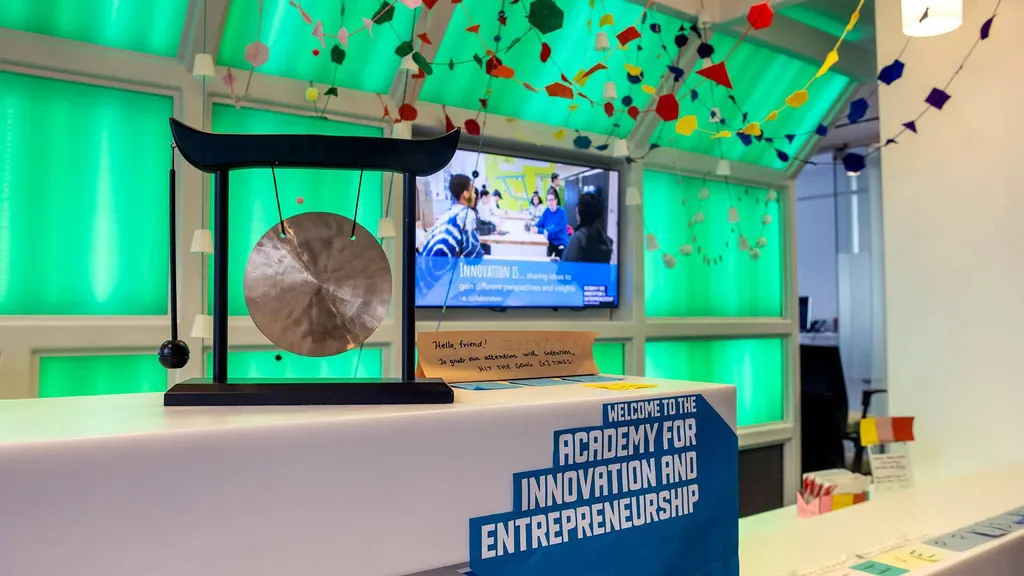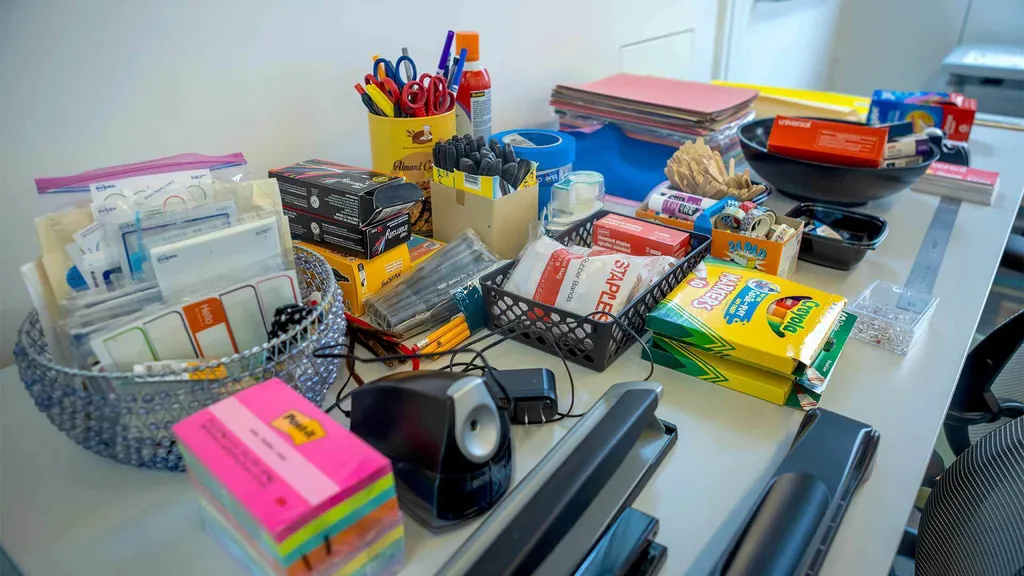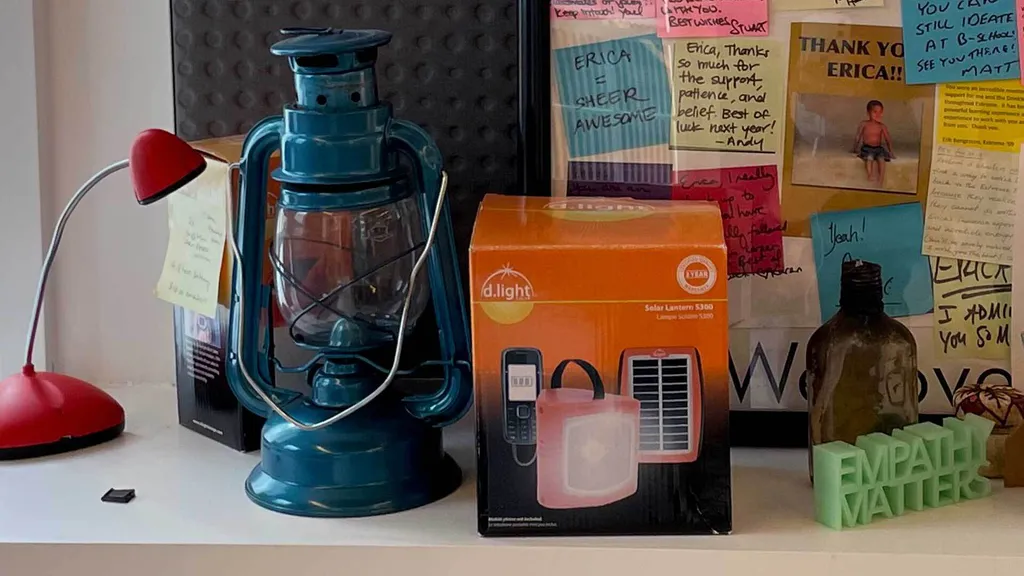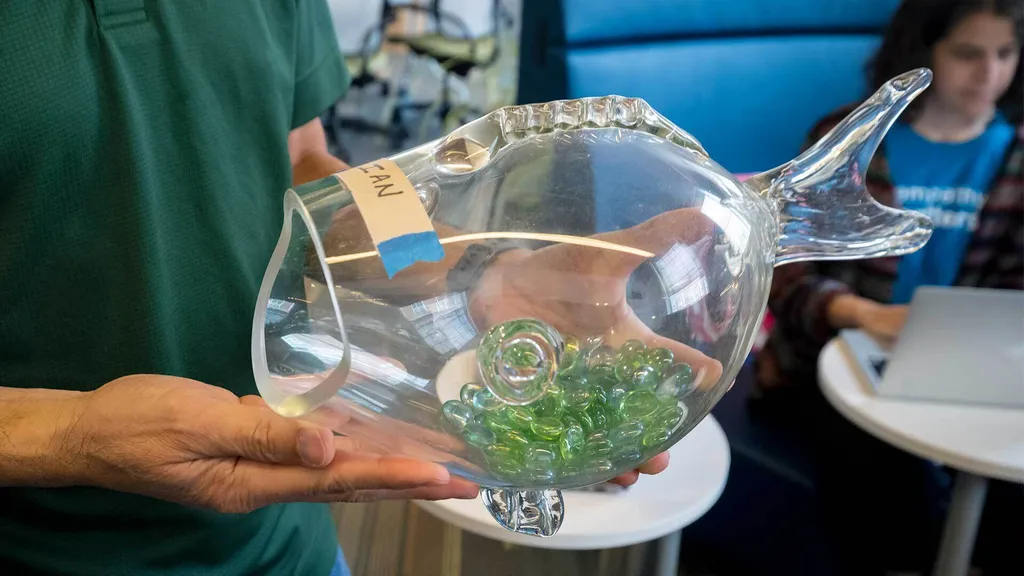- May 03, 2022
- By Karen Shih ’09
Looking for a place to dig into your outside-the-box ideas? Just step into the Academy for Innovation and Entrepreneurship (AIE) office, where its neon “garage door” entrance, colorful strings of disposable cups, tiny pom-poms and paper cut-outs, and free notebooks will get your creative juices flowing.
The welcoming, eclectic space in the Edward St. John Teaching and Learning Center is home to a staff of five who work with all 12 colleges and schools to integrate design thinking and “lean startup” concepts—a methodology that prioritizes customer feedback and flexibility—into nearly 200 innovation and entrepreneurship courses at the University of Maryland. The academy also offers workshops for offices and organizations both on and off campus. “A lot of groups asked us to reimagine how to work collaboratively while virtual or hybrid during the pandemic,” said Brooke Smith, AIE’s assistant program director.
AIE’s shared office features a prototyping area with materials for crafting, collaboration tables of different heights in the center of the room, as well as high-backed half-circle chairs that have become the de facto meeting area.
“I like the flexibility of our space,” said Design Thinking Facilitator Christina Hnatov. “These tall tables are my favorite place to work. I like that I’m not locked at my desk all day because we get up and move around so often. I really missed creating all the hands-on materials during the pandemic, so I’ve really enjoyed coming back and creating things in person.”
Smith, Hnatov and Dean Chang, the interim chief innovation officer and associate vice president for innovation and economic development who founded AIE, shared how they help students discover their creative and innovative potential, why they prefer hands-on to digital prototypes and some of their favorite objects around the office.

An unconventional entrance
“This is our metaphorical garage door, because garages are where a lot of ideas have started for companies,” said Smith. “We want to spark students’ creativity.”
At the unmanned reception desk, visitors can choose how they want to interact with the AIE staff. The gong comes with directions: Hit it once for a meeting, twice for a question and three times if you’re a fan of gongs. Next to it are kinetic sand, wooden blocks and Post-it notes.
“A lot of students come in and are like, ‘What is this place?’” said Smith. “They don’t know what to do or where to start, so having stuff like this just eases any awkwardness. It can help focus you, these fidgety things.”
All ideas are welcome at AIE, from new business ventures to new approaches to learning. The concept for Student-Initiated Courses (STICs), which allow undergraduates to design, develop and teach official one- or two-credit courses, came from one of AIE’s Peer Innovation Coaches, and numerous startup ideas have blossomed once AIE connected students with campus partners like the Dingman Center for Entrepreneurship or the Do Good Institute for resources.

An Analog Workshop
With popsicle sticks and pipe cleaners, felt and markers, the back of the shared academy office space gives staffers the tools to quickly throw together a board of potential new names for a class or a self-introduction hat to break the ice at a workshop.
“There’s something different between just telling someone an idea and showing them something they can interact with. You get different reactions and more interesting information,” said Smith. “Digital is fine, but people worry more about the aesthetics of it. If I show someone a piece of paper I quickly scribble on, our hope is that they will think more about the idea itself than the presentation of the idea.”

d.light Lamp
Co-created by Erica Estrada-Liou, AIE’s interim executive director, when she was a student at Stanford University, the d.light is an inexpensive, solar-rechargeable LED light that is now distributed in countries such as Myanmar and India.
Smith said, “She has a presentation where she brings this regular blue lantern to her class to explain how people in the developing world get light” with kerosene and matches, which can be expensive, low-quality and a fire hazard. Estrada-Liou then discusses how that led her to create the d.light. “She could just tell them the story, but it’s great to have this prop to bring the story to life, so students can see the difference and envision the impact on people.”

The “Ian” Fish
Named for one of the academy’s first student peer innovation coaches, Ian Moritz ’16, the fish-shaped former fishbowl is frequently incorporated into classes and activities, with different prompts or topics written on slips of paper for participants to select from the fun container. Smith said Moritz was “happy his fish’s old house was being used to foster innovation.”
Chang said, “Ian was very, very engaged with the academy and part of a group of students we recruited to help us define what the mission statement of the academy should be. We knew early on that it was critical to get student input.”
Today, Chang estimates that half of all students have been exposed to I&E concepts on campus, far surpassing his initial goals when the academy was established in 2013.
This is part of an occasional series offering a look inside some of the most interesting faculty and staff offices around campus. Think you have a cool workspace—or know someone’s that you’d like to recommend? Email kshih@umd.edu.
Topics
Campus & CommunityTags
A Peek Inside